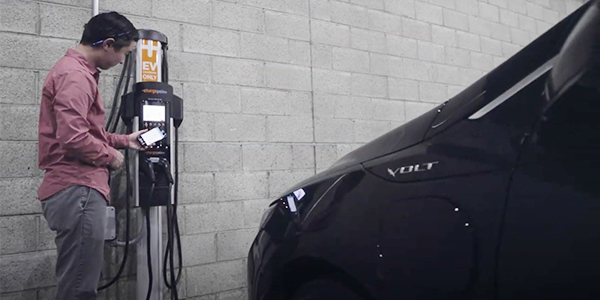The California Public Utilities Committee on Thursday greenlit a major expansion of the largest utility-run electric vehicle charging program in the nation and approved contracts signed by investor-owned utilities to procure 1.2 GW of battery storage.
The contracts were signed in response to a CPUC procurement order in 2019 intended to head off projected shortfalls starting in the summer of 2021, but the shortage conditions arrived a year earlier than expected. A weeklong August heat wave across the West strained grid conditions and led to the rolling blackouts of Aug. 14-15.
CAISO Blames Blackouts on Inadequate Resources, CPUC.)
The CPUC also renewed the state’s Electric Program Investment Charge (EPIC) program for another 10 years, providing nearly $1.5 billion for research and development during that time. Grants from the ratepayer-funded program are distributed by the California Energy Commission to finance cutting-edge clean energy, storage and EV projects, among others.
“Developing new technologies and solutions that are laser-focused on improving reliability, safety and affordability attracts investment to California and keeps our clean economy growing,” Commissioner Martha Guzman Aceves said in a statement. “Several EPIC-funded microgrids even supported the grid during the recent grid crisis, demonstrating real-time value to ratepayers.”
1.2 GW of Battery Storage
In 2018, the CPUC and CAISO identified potential capacity shortfalls starting in the summer of 2021 and extending for at least several years, caused by the state’s shift to solar and wind power and away from fossil fuel plants.
The projected shortfalls, like the rolling blackouts of mid-August, could be triggered by peak summer demand shifting to later in the day, as the sun sets and solar power wanes. Continuing high demand during the “net-peak” hour can strain available supply.
To ensure resource adequacy, the CPUC in November 2019 ordered the utilities under its authority to collectively procure 3,300 MW on a pro rata basis. (CAISO had asked for 4,700 MW and blamed the CPUC for coming up short, following the rotating outages.) The procurement contracts the CPUC approved Thursday were the first tranche of resources under the reliability effort.
The commission ordered Pacific Gas and Electric, the state’s largest utility, to procure 717 MW of new resources by 2023. At least half that amount must come online by Aug. 1, 2021, it said. (See California PUC Votes to Keep Old Gas Plants Operating.)
PG&E submitted seven contracts to the CPUC for 423 MW of lithium-ion battery storage, all of which the regulatory agency approved Thursday. PG&E said the storage projects all will come online by next July.
Under the agreements, Dynegy Marketing and Trading will operate a 100-MW battery storage facility at its Moss Landing natural gas plant on Monterey Bay; Coso Operating Co. will provide 60 MW of battery storage at its 145-MW geothermal project at the U.S. Naval Weapons Center in Inyo County; and NextEra Energy Resources Development will operate a 63-MW storage facility at its 225-MW Blythe Solar Energy Center in Riverside County.
PG&E contracted with Diablo Energy Storage for three battery projects totaling 150 MW in the San Francisco Bay Area and with LS Power Group’s Gateway Energy Storage for a 50-MW standalone project in San Diego.
The CPUC approved seven contracts signed by Southern California Edison for 770 MW of battery storage. In its 2019 order, the CPUC required SCE to procure nearly 1.2 GW of new resources by 2023, with at least half operational by August 2021.
SCE contracted with NextEra for approximately 230 MW of storage at the Blythe facility and for 230 MW at its McCoy Solar Energy Center in Riverside County; with Gateway for 100 MW of storage in San Diego County; with Southern Power, a subsidiary of Southern Co., for 150 MW of storage at its solar arrays in Fresno and Kern counties; and with Terra-Gen for 50 MW at its Sanborn facility in Kern County.
The CPUC approved all seven SCE contracts, some of which are tolling agreements or RA-only contracts.
“California recently experienced reliability challenges not seen in decades, and we are working to identify the root causes,” Commissioner Genevieve Shiroma said. “Our decisions today continue to build the foundation of our resource adequacy program by securing additional contingency resources for use when needed.”
Largest EV Charging Program
Also on Thursday, the CPUC authorized $437 million to fund the installation of 38,000 charging ports for EVs via SCE’s Charge Ready 2 infrastructure program, the largest single-utility EV charging program in the U.S., according to the commission.
SCE originally asked for $760 million, but the CPUC said its decision reduces ratepayer costs by 40% while reducing the number of charging ports by just 20%, partly by lowering the estimated cost per port to $15,000 from SCE’s requested $19,000.
The Charge Ready program started in 2016 with a pilot program of 1,500 charging ports and began expanding in 2018. The program prioritizes low-income communities and apartment buildings “because they face barriers to transportation electrification,” the CPUC said in a statement.
The program includes infrastructure upgrades to support EV chargers, including higher-voltage electric panels, conduit and wiring. A construction rebate offsets installation and charger costs for new multiunit dwellings that exceed state or local building codes.
Program participants must sign up for demand response programs and accept time-of-use pricing to align charging incentives with grid conditions, the CPUC said.
“This decision furthers California’s ambitious goals to increase [zero-emission vehicles to 5 million by 2030] and end harmful tailpipe pollution by filling gaps in the state’s EV infrastructure,” Commissioner Cliff Rechtschaffen said in a statement.




